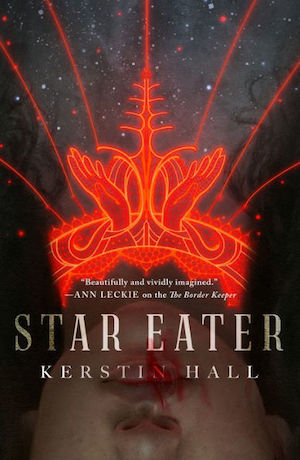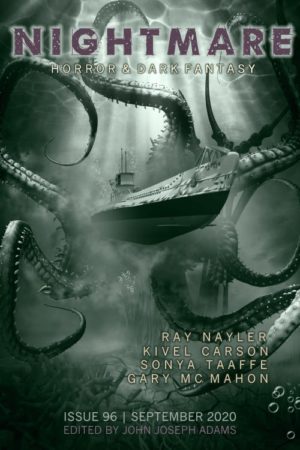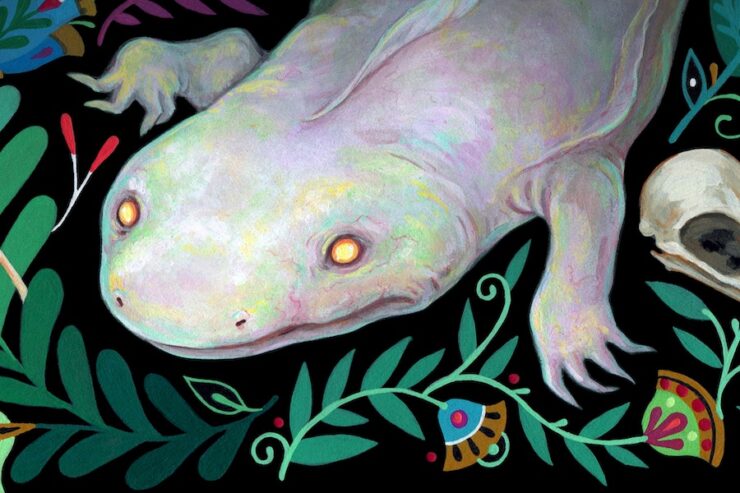Welcome back to Reading the Weird, in which we get girl cooties all over weird fiction, cosmic horror, and Lovecraftiana—from its historical roots through its most recent branches.
This week, we’re reading Sonya Taaffe’s “Tea With the Earl of Twilight,” first published in the September 2020 issue of Nightmare Magazine. Spoilers ahead—but go read it for yourself first, we’ll wait.
“It had been a wet, dispiriting winter full of gusts and mists, but with January the water had finally hardened into a thick pane of cormorant-black ice, chipped and glossed with refreezing like volcanic glass…”
Sid Eilerstein is a two-time grad-school drop-out currently working temp jobs and sharing a Spring Hill apartment with her friend Daniel, whose gigs in radical queer game design just about cover their internet costs. Her walk to work takes her along the Broad Canal boardwalk, and it’s there she first sees the man.
He slouches against the rail of an abandoned canal-level loading dock, smoking a cigarette; at first she takes him for a power plant worker, though his thin black sweater and dark corduroys are more suggestive of an art student. His face is pale and pointed, his ashy hair rumpled. He doesn’t look up; later she wonders why she thought he should have. After several sightings, she wonders whether he covertly watches passersby or just the motionless water.
One evening, Daniel sends her a link to the obituary of Geoffrey Axtell, 79, “portraitist of Boston’s waterways.” Sid searches Axtell’s paintings, notable for an “almost metallic crispness, bright flat pastels or unmixed oils sharpened the one degree past photorealism that made the Brutalist bricks of City Hall Plaza or the tumbling bronze dolphins of the old New England Aquarium seem to scratch their way off the screen.” Humans are afterthoughts, save for one figure that rivets her attention: the silhouette of a man lounging on a canal dock, smoking. The title of the painting is The Earl of Twilight, 1981. Recognizing her lounger, Sid is shocked into closing her browser. After conquering her fear and anger, she reopens the picture, knowing, even then, “as with every real haunting, it had always been too late.”
For the next week Sid avoids Broad Canal, but dreams of Axtell’s paintings shifting behind her back, the smoker “flicking from canvas to canvas like stop-motion film.” With her non-binary lover Torrey, she attends Axtell’s memorial exhibition. Torrey tries to soothe Sid’s nerves by aping an art critic’s jargon-heavy posturings, suggesting that that Axtell’s “subjects were trying to project themselves forward into a past they’d already lived.”
Sid and Torrey step around a partition and come face to face with The Earl of Twilight. It vibrates more deeply blue than Sid remembers, and seems to breathe the “wet smell of the canal.”
Someone comes up behind the pair, saying: “He painted that for his brother.” The “glam grandmother” introduces herself as Sheila Francis, a long-time friend of Axtell’s, and tells the tragic story of Geoff’s younger brother Hilary.
Buy the Book


Star Eater
Geoffrey and Hilary were born in England, both artists, though Hilary quit school to make sculptures out of scrap, “vivid, angry little things” that blurred the line between screws and bones, a “retinue of demons.”
Oh, and Hilary was murdered. Probably queer-bashed and dumped into an old canal. A year later, Geoffrey came to Boston and painted Hilary into The Earl of Twilight. Apart from the painting, there’s little left of Hilary, maybe his sculptures if he ever sold them, a police file somewhere. Francis won’t be around forever. Somebody should know.
Sid rushes from the gallery, furious that Francis has “handed her a dead man’s memory like a party favor, as if she was not haunted enough.” When Torrey catches up to her in the freezing dusk, Sid blurts that Geoffrey transplanted his brother to a ghostly existence in Boston. Does Francis know he’s here? Did she expect Sid to exorcise Hilary?
Torrey holds Sid, suggesting Geoffrey probably didn’t mean to paint his brother so deeply into Boston. If he’d meant to cast a spell, wouldn’t he have done more than one Hilary pic?
Sid laughs, with love, at Torrey’s rational-irrational reasoning. The next few days she searches for images of Hilary’s sculptures, finding none. Walking through the city, she channels Hilary on the night of his murder, unable to outrun his pursuers but trying anyway with night and snow coming on.
Two days later Sid returns to Broad Canal, carrying a matcha latte and pistachio-cherry tart. It’s stupid, Hilary didn’t even die here, but “he had brought his death with him as surely as Geoffrey Axtell had brought his memory and now none of them could be separated.” She imagines Axtell’s ghost will still haunt the dock when the rising tides of climate change engulf it, and then his cigarette will glow under the water like a phantom light….
Sid hears a match struck, smells cigarette smoke. She sees Hilary clearly now, pensive and windblown, wearing the winter garb in which he died. She’s not surprised, though still terrified, when he looks up at her. As she reaches out and takes his cigarette from his hand, his eyes widen in surprise.
Did she expect to feel the cigarette smear like turpentine or rust? All she feels is ash, all she hears (perhaps) is brief laughter and glass breaking, like fever. She’ll never know what she’s unbound into her “endlessly building, sea-dredged, sinking city,” not unless she meets him again under the water. If Hilary constructs “skeletal maps” of a Boston to come, she won’t look for them.
She knows the future has always been too late.
What’s Cyclopean: As always with Taaffe, brilliant descriptors abound: cormorant-black ice, mornings as grey as salt-streak concrete (and later a salt-black night), dusks as drowned blue as a harbor’s underside, Boston consuming itself in the sterile alchemical style of an insensate ouroboros. More traditionally, Daniel listens to something (The news? True crime? History ?) on his headphones, “his ears obliviously stopped with eldritch horrors that could never be worse than fiction.”
The Degenerate Dutch: Hilary Axtell was murdered in a queer-bashing hate crime, and queer fear and love and aesthetics are woven through both his haunting and the story as a whole.
Weirdbuilding: As Taaffe points out in an adjacent author interview, “touching through time” is core to both ritual and cosmic horror. The past shaping the future, the future shaping the past, is sometimes awe-inspiring and sometimes frightening and always Weird.
Libronomicon: The glass-cube architecture of Sid’s office is “the apocalypse according to Ballard,” and Torrey is Virgil to Sid’s Dante.
Madness Takes Its Toll: No madness this week, though some pretty intense nightmares.
Anne’s Commentary
Coincidence or synchronicity: Just before diving into Taaffe’s “Tea with the Earl of Twilight,” I finished reading Douglas Wynne’s fine Mythos novel, Red Equinox, also set in the historical lasagna of Boston so dear to urban explorers. The conceit that Boston’s “an endlessly building, sea-dredged, sinking city” pervades both works, acknowledging that it was born of wetlands and to wetlands will climate change return it, ashes to ashes, dust to dust, and, sure as the tides, water to water.
I’ve been fascinated with the ruined, discarded, hidden aspects of cities since long before urbexing was a neologism. My hometown of Troy, New York, was one of the early industrial centers of the Northeast; as such, it boasted (or rather, didn’t boast about) many abandoned mills and factories, train yards and tunnels, canals and bridges and docks along the Hudson. My friends and I were always poking around these places. No one called us urban explorers, though, just those goddamn rotten kids that were going to break their goddamn necks, and good riddance. Despite waves of urban renewal, Providence offers similar delights. So must all old cities under their outermost layers of architectural skin, the shiny ones preferred for display by municipal officials and by citizens not drawn to the glamor of well-aged grime. Those would be the decent and productive citizens, by the way. The ones, clearly, who haven’t dropped out of grad school twice and covered themselves to the sleeve cuffs with tattoos. Who don’t squeak by on temporary work and have gay roommates who disturb raccoons with their sexual athletics and consort with lovers pronouned “they.”
Maybe I’m wronging the decent and productive citizens. Maybe some of them would notice the loading docks of disused canals and have the requisite sensitivity to perceive their resident ghosts. However, it’s Sid, nee Siddony, who does notice one particular ghost loitering on the edge of stilled water and bygone industry, liminal, marginal.
By no accident is Sid the one to see and ultimately “unbind” Hilary Axtell. One quick and one dead, they appear to be kindred spirits, droppers-out who may be dropping-in to more authentic selves, aqua-industrial aesthetes. Geoffrey Axtell is also an aqua-industrial aesthete, dedicated portraitist of Boston’s waterways. Or did Geoffrey only devote himself to urban aquascapes after his brother died and he painted him as the Earl of Twilight, thus creating his whole subsequent American oeuvre out of sorrow, or guilt, or their amalgam?
In this story Taaffe offers no definite explanations for her haunting, either to validate or to dismiss it. Instead she offers a web of possibilities as complex as Boston’s overlapping-overlying realities, spatial and temporal—as complex and as beautifully compelling as the language and (dare we say Axtellian) imagery with which she weaves it. In this, “Tea with the Earl of Twilight” reminds me of our recently-read Aickman story, “Stains.” Another coincidence or synchronicity: Robert Aickman was the great preserver of English canals! Hilary Axtell was found in the winding hole (turning-around spot) of a defunct English canal! Broad Canal is a canal! Wait, what about Everil Worrell’s “The Canal,” which we covered way back in September, 2019? With its vampire trapped above the waters of a stilled canal? Is it the very stillness of Broad Canal that traps Hilary?
My mind works in mysterious ways at the moment, mysterious being a nice way to put it. Did someone in the safe darkness of the theater’s highest balcony suggest the word delirious?
I blame it on Taaffe-intoxication, no unwelcome thing.
About Sheila Francis. Is this absolutely fabulous elder lady a witch or a seeress, zooming in as she does on Sid as the true heir to Hilary’s memory? Reading over her unsolicited confidences, I’m struck by her idea of Geoffrey as being the one who got away, though she can’t say from what or with what. Maybe that was it, she adds, pointing at The Earl of Twilight. Getting away from or getting away with could indicate her suspicion Geoffrey had something to do with Hilary’s death, likely something indirect but instrumental enough to plunge Geoffrey into guilt he tries to expiate by carrying Hilary to Boston and painting him into a place he’d have loved. If Torrey’s right that Hilary didn’t haunt the actual dock until after Geoffrey died, then Geoffrey’s death has freed him from the painting but not the place. Sid, who sees him there, must give Hilary his final liberation by acknowledging his presence, locking eyes with him, touching him.
I’m going to stop irrationally rationalizing now. Final observation and appreciation: “Tea’s” another story about weird artwork I’d love to own. Let me hang The Earl of Twilight between a couple of Pickman’s ghoulscapes and set a pair of Hilary Axtell’s scrap-demons on my coffee table. While we raise matcha lattes to them, we’ll listen to a rare recording of Erich Zann’s last violin sonata. Ah, what a perfect evening, diamante black masks not optional.
Ruthanna’s Commentary
There’s something inevitable and intriguing in stories about art. It’s hard to dance about architecture, but we write about painting all the time, verbal creators fascinated by the wizardry of visual ones. In weird fiction that wizardry may be literal, or painting may simply be a way to share the strangeness one has fallen into. Pickman does the latter, revealing the inescapability of death via its ghoulish scavengers. Arthur Crispin goes a step further, showing the rot under the surface so clearly that he summons its avatars; Neveah summons the King in Yellow. In “All Our Salt-Bottled Hearts,” our earlier Taaffe story, a Deep One artist uses paint to portray and mirror her anticipation of, and transformation to, someone who can directly appreciate the wonder and glory of Y’ha-nthlei. Geoff Axtell straddles the line, his paintings both memory and perhaps-accidental magic.
Another blurring of arts: I’m 90% sure that Sheila Francis’s heavy gorget: “all tangled silver wire and chips of nacre and the parhelion flash of labradorite,” is an Elise Matthesen necklace-crown. Elise won a 2020 Hugo for her jewelry, which has itself inspired or provided a muse-ish push to any number of stories. (“The Litany of Earth” has an associated Elise pendant, a labradorite-and-octopus wirework entitled “Going Between.”) [ETA: I cheated at literary criticism and asked the author: it’s a fictional Elise necklace based on three pieces Sonya actually owns.] It is not entirely surprising that someone wearing one of those necklaces would step in as an oracle of sorts. Or a prophet, bearing unwelcome but necessary knowledge.
Because the necessity—the obligation—of painful knowledge is a theme woven through this story’s core. Knowing hurts, and knowing is dangerous. But not-knowing doesn’t make you safe either, and certainly doesn’t make you a better person. Sid’s haunted by Hilary’s life and death, and by his fear of attackers who would have been equally dangerous to her and her lover. But even before Hilary, she’s haunted by the shadow of climate change, of a future in which the sea will take back a city that she knows deeply and intimately. If you know that someday Cthulhu is going to rise and oveturn all, what should you do? Why speak the names of the dead, the murdered, when larger horrors await? You can’t make the problem never-was, can’t return to a pre-anthropocene, pre-knowledge innocence—you have to work with the present you’ve got and the futures it leaves open. So this is a story about little fixes—or even just changes, getting things moving that were held in stasis—amid huge, terrifying realities that aren’t going away.
I’m drawn to Taaffe’s statement in the associated interview: “When people try to treat nostalgia like sympathetic magic, very bad things—like nationalism—happen. The important thing is to be here, and now, and aware of what’s under your feet. Sometimes it’s the sea. Sometimes it’s bones.”
Part of that here and now is the sense of place that also runs through the story. Sid is a deep explorer of Boston. She’s walked the streets and paths, knows the layers of history and building and the hubristic fight against the water (both its future rise and the tenuousness of its original banishment). Cities are big enough to be comforting and frightening, known and strange—and they don’t hold still. Torrey describes a “once and never city laid down in the littoral of time” where the waves of history flow in and wash out again, past and anticipated future shaping each other, never fully reachable. Knowing the city, therefore—belonging there—is likewise a moving bar. To be autocthonous—not “self-shadowing” as I originally parsed it, but beyond indigenous, originating in the place where you’re still found—is near-impossible.
This story is gorgeous and painful, and achingly appreciated during a time when eldritch horrors sometimes come perilously close to being worse than fiction.
Next week, we continue our shadowing way through The Haunting of Hill House, Chapter 4.
Ruthanna Emrys is the author of the Innsmouth Legacy series, including Winter Tide and Deep Roots. Her short story collection, Imperfect Commentaries, is now available from Lethe Press. You can find some of her fiction, weird and otherwise, on Tor.com, most recently “The Word of Flesh and Soul.” Ruthanna is online on Twitter and Patreon, and offline in a mysterious manor house with her large, chaotic household—mostly mammalian—outside Washington DC.
Anne M. Pillsworth’s short story “The Madonna of the Abattoir” appears on Tor.com. Her young adult Mythos novel, Summoned, is available from Tor Teen along with sequel Fathomless. She lives in Edgewood, a Victorian trolley car suburb of Providence, Rhode Island, uncomfortably near Joseph Curwen’s underground laboratory.














“all tangled silver wire and chips of nacre and the parhelion flash of labradorite,” is how I think of Taaffe’s work.
Lovely story- and now to re-read Salt-Bottled Hearts for the nth time.
I must say this was one of those very rare stories which bored me so much that I began skipping parts halfway until I got to the end. At least it was not boring enough for me to give up on entirely, which is something I do a lot more often. That’s the best I can say about it.
Mmm. I once lived in Boston for three months, interning at the New England Aquarium, and it has magnetically pulled on me ever since. My experience was entirely different from Sid’s, not least because I gave little thought to history and architecture while spending much of my free time searching for locales not covered in concrete. But if I had been there in winter and seen those frozen waterways, I might have written similar descriptions of them.
Damnit. Octopuses and labradorite are two of my favorite things, and I want a necklace that combines them.
Aerona, you definitely want to keep an eye on Elise’s shop, because that’s a combination that happens in her pendants on a regular basis. (If you’re flinching at the prices, she also has major sales on a regular basis, which is how I come to have a number of pendants combining octopodes and interesting stones.)
Thinking of verbal creators fascinated by visual creation, I tend to think about Jeffrey Ford’s The Portrait of Mrs. Charbuque, not only for its immediate attention to the delightfully weird commission of the titular work, but also for the artist’s own fascination with the work of Albert Pinkham Ryder, whose The Race Track (Death on a Pale Horse) just about haunts the novel. And that is another work that likely is, along with The Earl of Twilight or Pickman’s models, not a “Goes well over the sofa” piece.
What a knack for description, Sonya Taaffe had me digging in my pocket to smell my keys, and her terms for colors were so exact… fantastic!
This story reminded me of Fritz Leiber’s The Smoke Ghost, with the narrator slowly realizing that the city is being haunted by a new form of ghost. If Leiber’s ghost was composed of smog, mid-century angst, and industrial urban malaise, Taaffe’s ghost seems to be composed of broader environmental calamity, healthy fear of bigots, and post-industrial urban malaise. She conjured up a new form of haunting, a powerful work of, to channel Leiber again, Megapolisomancy.